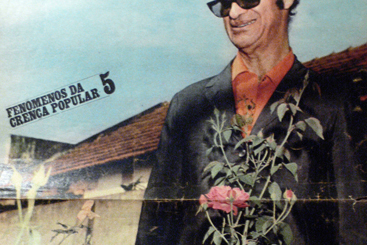
Born in 1967 in Belo Horizonte (BR)
Lives between Copenhagen (DK), New York (US) and Rio de Janeiro (BR)

2008 - 2009
Slide projection with voice-over, 20’
B&W and color
English narration by Charlotte McGowan-Griffin
Sound: Jasmine Guffond
Durée : 20’
Year of Purchase: 2010
Combining in her work pre-existing images and spoken word excerpts, Tamar Guimarães views archival documents as palimpsests, objects which are constructed through successive destruction and reconstruction, even while preserving a history of former traces. In this sense, Tamar Guimarães considers historical narratives as “spaces” that make it possible for us to bank on the present.
A Man Called Love (2008), a work composed of a slide projection and a soundtrack, reconstructs the true story of Francisco Candido Xavier, aka Chico Xavier (1910–2002), the most notorious and prolific Brazilian medium of the twentieth century, who under the influence of “spirits” produced over four hundred spiritual books of wisdom. Chico Xavier popularized the “spiritist” doctrine first developed by Allan Kardec in his introduction to the Book of Spirits, published in 1857. This doctrine is grounded in the existence, manifestations, and teachings of spirits, mostly disembodied humans.
Using psychography, or spirit writing by the hand of a medium, Chico Xavier claimed, in 1931, that he had seen his spiritual “mentor” in the form of a spirit named Emmanuel. Guided by this invisible being, he published his first book in July 1932, Parnassus from Beyond the Tomb, a collection of sixty poems attributed to nine Brazilian poets, four Portuguese poets, and one anonymous poet, all dead. This work of “high poetry,” produced by a humble store clerk, who signed it using the names of deceased authors, provoked widespread astonishment. Chico Xavier received countless expressions of homage from regular people as well as from public authorities.
For Tamar Guimarães, the life of Chico Xavier has allowed her to address questions about racial relations and social ills in Brazil in the Vargas Era from 1930 to 1950 and under the military dictatorship from 1964 to 1985, periods during which Chico Xavier enjoyed the greatest popularity. She thus notices a connection between the development of Spiritism in Brazil and the emergence of socialist utopias, followed by a distancing from the latter by the dictatorship.
Notwithstanding, A Man Called Love brings to light the hidden fractures in the “spiritist” practice of Chico Xavier, revealing an interconnection between the military dictatorship and the resistance.
Tamar Guimarães reproduces public archival images of Chico Xavier’s spiritist practices in the 1930s and 1940s in Brazil, as well as images of protests against the military regime of the 1960s. She uses the biography as a starting point for her exploration of the rifts between art and the documentary. A Man Called Love is more than a simple experimental documentary. In this slide show, which is so astounding that sometimes it seems to be pure fiction—even while it is based on real events—the artist evokes historical and sociopolitical processes, explicitly or implicitly embodied by Chico Xavier.
This text was published in a magazine edited on the occasion of the exhibition The Watchmen, the Liars, the Dreamers, curated by Guillaume Désanges and presented at the Plateau/FRAC Île-de-France from Sept. 16 to Nov. 14, 2010.